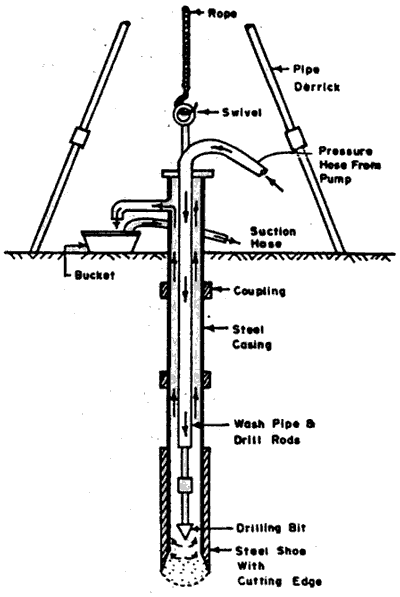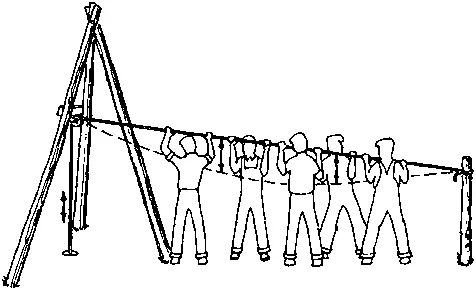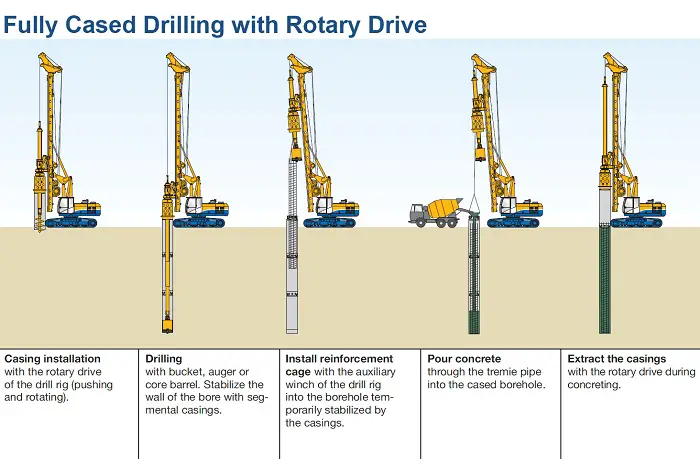There are couple of available methods to drill a well. Choosing a method depends on many factors including soil type, underground water level and common practice in the country. Cities using groundwater usually depend upon deep wells. These wells have the advantage of tapping deep and extensive aquifers. Such deep water is likely to be of good sanitary quality unless it is contaminated bt seepage into the aquifer from coverns or fissures in overlaying rocks. All deep wells are drilled wells. The successful digging of drilled wells requires special tranning, experience, tools and equipment.
Methods to Drill a Well
Among the various methods of drilling wells 5 are used most commonly:
- Standard method
- California stovepipe method
- Jetting method
- Core drill method
- Hydraulic rotary drilling method.
Standard Method:
The standard method involves percussion drilling in which a drill is alternatively raised and dropped in the descending borehole. It is suited to the drilling of wells in any material from soft clay to the hardest rock. Modifications of the standard method include the ‘Pile tool’ method in which a wooden rods are used instead of rop and the ‘hollow rod’ method in which a hollow rod replaces the rope to support the boring bit. Water is pumped into the top of the well between the casing and the hollow rod. The water leaves at a relatively high velocity through holes in the bit and rises through the hollow rod carrying the cuttings with it and permitting continous advance of the well without the withdrawal of the bit to remove cuttings.
California Stovepipe Method:

It was first used in California. It is used in unconsolidated alluvial deposits. It consists of pushing by means of hydraulic jacks, steel cylinders with wall thickness of 0.1 to 0.16 inch and 2 to 4 ft long into the earth. Cylinders of two diameters are used, one size just slipping within the other, the joints of the outer cylinder falling midway between those of inner cylinder. The inner and outer casings are locked together by denting them with a pick and successive length of pipes are added and sunk. As sinking progesses the casing is kept even or ahead of excavation. The material inside the casing i\being removed by use of a bailer or clamshell bucket. The california stovepipe method has been used on wells 6 to 36 inch in diameter and upto 200 ft deep.
Jetting Method:
Jetting is accomplished by means of a drill pipe having a nozzle or a drill bit on the lower end. Water is pumped down through the drill pipe and escapes through the drill bit, which is raised, lowered and turned slowly. The strem of water loosens materials and the water rising through the casing lifts the finely divided cuttings from the well. This method of drilling is suitable in soft, unconsolidated alluvial deposits, depths upto 400 to 500 ft. In suitable materials, a well can be drilled by this method faster than by any other method.
Core-Drill Method:

Core drills consist o of a hollow but armed with diamond or steel teeth on the annualar circumference of the bit. The hollow bit is attached to a drilling rod and rotated, water being used to remove the cuttings.
Rotary Drilling Method:
In rotary drilling method, a cutting bit is attached to a hollow drill rod rotated rapidly by an engine driven rotary table. Either water or a suspension of colloidal clay is pumped down the drill pipe, flows through opennings in the bit and transports the loosened materials to the surface. The clay suspensions are designed to reduce loss of drilling fluid into permeable formations, lubricate the rotating drill pipe, bind the wall against caving and suspend the cuttings.
Installation of Wells
After the boring of the well has been completed to the desired depth, the blibk pipes and strainers are to be lowered and fixed to the position. The bore hole is always to be drilled a little more than the installed depth of a well, so as to make allowance of materials which may cave in before shrouding of the well.Strainers are to be located opposite water bearing strata to draw water from them. This si done by assembling on te ground together with the whole length of the strainers and plain pipes exactly in the same order and length in which they are to be lowered in the bore. Every pipe, socket and strainer is numbered serially. There is a length of about 4 to 5 ft of plain pipe at the bottom with a cap to close the bottom end. The cap has an eye on the inside with which a hook lowered from the top, inside the tube can be made to contact whenever necessary. If a hook tied to a wire rope is lowered into a well from ground level it can be easily made to contact this eye at its bottom endand the whole tubewell can thus be lifted with the wire rope and kept suspended by it. This method can be used for extracting a newly lowered tubewell where necessary.
The strainers and plain pipes are lowered inside th boring tube one by one as required starting from the bottom end and in the same order in which they have been assembled at ground level. This is doen by fixing a pair of clamps at the top of the end piece and then lowering it inside the boring tube till it rests on it. The next piece is then screwed or welded on top of the bottom piece and a scond set of clamp is fixed at the top end of the upper piece. The upper clamp is tied to the wire rope going round the pulley at the appex of a tripod. The end of this rope is colled round a crab winch. The rope is tightenned up till it takes the whole weight of the pipes to which the clamp is fitted and raised these a few inches. This lifts the lower clamp from the top of the boring tube and enable it to be released. The lower clamp is then removed and wire rope is gradually slackened and the tubes lowered into the bore till the upper clamp rests on the top of the boring tube. The wire rope is now removed and the next pipe is screwed on top of the lowered pipe and the whole operation repeated as before. Thus, one by one the whole series of pipes and strainers are lowered inside the boring tubes to the correct level. The whole finished length of these pipes and strainers is now kept suspended from the top and the boring tubes are jacked up and extracted one by one. Before the boring tubes are extracted, the shrouding materials are dropped and the bore hole is filled. These shrouding materials grip the strainers and pipes on the outside and help to hold in position. Before starting lowering of strainers and pipes inside the boring tubes, the latter are raised to such a level of the bottom end is only slightly below the proposed level of the bottom of the finished tubewell, so that the bottom end of the tubewell will rest on the shrouding materials when lowered in position.




It is interesting to learn that there are multiple ways to drill a water well. I have wanted to drill a water well in my backyard for a long time now, to try and live off the land. These are great tips on how to do that.
Wow, the fully cased drilling with a rotary drive looks pretty great. When digging a well, how can you know where to create the hole? I would think that there are instruments that can somehow detect underground aquifers; however, I don’t know.